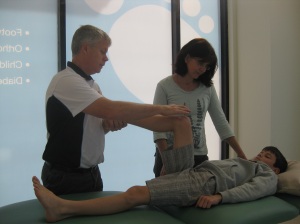About 80 per cent of our patients are cured of their fungal nails. And this success rate ties in with the statistics being collected by German company ARC Laser, who designed our laser. Their research with podiatrists world wide is showing the same success rate.
But, here's a look at some weird and wacky ideas. Some of them sound very involved and very smelly!
First grandma cure - garlic
 |
| One 'cure' says to put garlic cloves in your bed socks. |
It says to sprinkle your toes with powdered garlic or crushed garlic, finding a way to keep it in place on your feet for 30 minutes each time.
And if your infection has only just started, wear socks to bed, with garlic cloves next to your toes.
At least it'll keep the vampires away!
Second grandma cure - lemon
Coat your nails in lemon juice as often as possible - several times each day.
Third grandma cure - henna
Grind some fresh henna leaves and add lemon juice and turmeric until you have a paste.
Then somehow you're supposed to 'apply' this paste to your nails at night and wrap your feet up with a cloth so the paste doesn't just dry and fall off.
Keep doing this night after night until you see results.
Hmmm, I'm seeing disrupted sleep and henna- and turmeric-stained sheets.
Fourth grandma cure - sulphur
Mix sulphur with coconut oil to make a thick paste.
Again, coat your nails each night and find a way to keep the paste on your nails all night!
And keep doing this every night until the fungus is gone.
We've found that it can take a year to get rid of all signs of fungal nails because nails grow so slowly. So this would be a very messy year!
Fifth grandma cure - potatoes
The recipe for this 'cure' is to peel and grate half of a small potato and mix it with a teaspoon of turmeric.
Once again, you need to find a way to keep this past on your nails all night and keep doing the treatment every night.
Sixth grandma cure - turmeric
 |
| You can buy turmeric fresh or powdered. |
Mix a small amount of turmeric with water or lemon juice.
And to add a new level of inconvenience, this recipe says to coat your nails with the paste twice a day for 30 minutes each time.
Seventh grandma cure - onion
This 'cure' says to coat your nails with onion juice every day or rub your nails with the cut side of an onion.
You can also mix the onion with lemon juice.
I don't know about you, but onion juice just makes me cry. I just hate the thought of this one.
I don't know about you, but onion juice just makes me cry. I just hate the thought of this one.
Eighth grandma cure - apple cider vinegar
This 'cure' says to coat your nails in vinegar or to add some vinegar to a foot bath and soak your nails for 30 minutes every day.
Ninth grandma cure - neem oil
Coat your nail with a few drops of neem oil three times a day.
Tenth grandma cure - tea tree oil
Coat your nail with tea tree oil or add some of the oil to a foot bath and soak your nails for 30 minutes twice a day.
Do you have any other 'cures' to add to this list? We'd love to hear about them.
Do yourself a favour - as they say - if you think you have fungal nails and you're in the Canberra region, phone Capital Podiatry on 6293 3300 or email us with any questions - admin@capitalpodiatry.com.au.
Do you have any other 'cures' to add to this list? We'd love to hear about them.
Do yourself a favour - as they say - if you think you have fungal nails and you're in the Canberra region, phone Capital Podiatry on 6293 3300 or email us with any questions - admin@capitalpodiatry.com.au.





